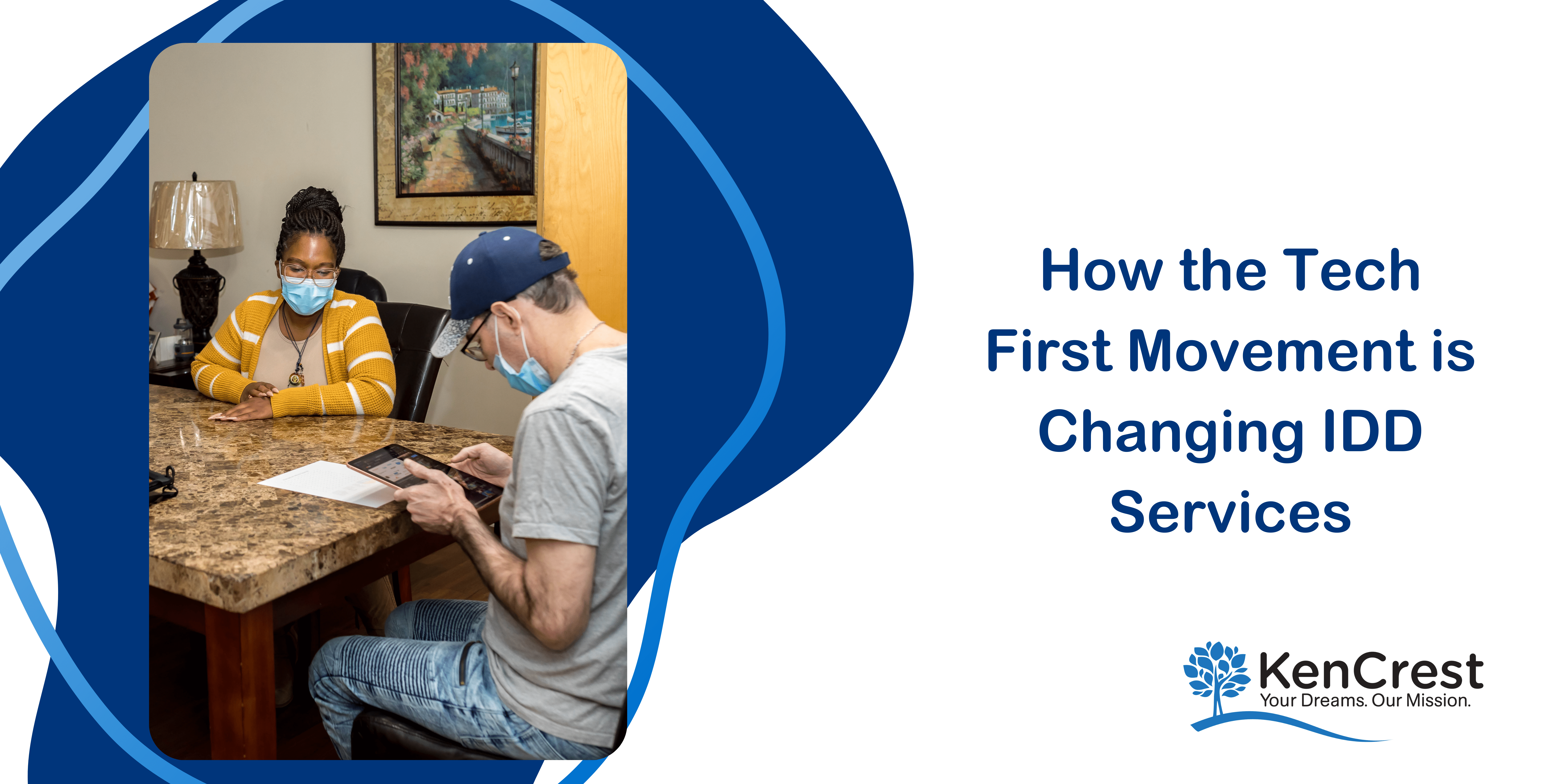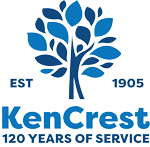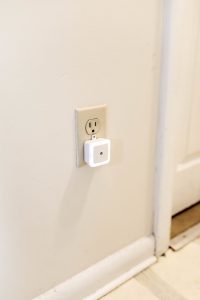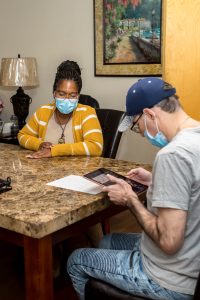
Providing access to both basic and cutting-edge technology is vital to the success of those supported by KenCrest.
Imagine what your life would be like without access to the many devices that help make getting through your day easier. Consider all of the technology you use to stay connected, informed, and on top of tasks around the home, at the office, at the gym, the grocery store, etc. As important as tech is to YOU, it is even more critical for people with disabilities who want to stay connected, interact with others, safely follow medicine regiments, perform successfully on the job and more. Enabling Technology (ET), or assistive technology, helps people compensate for impairments and overcome barriers to greater independence.
Enabling Technology is any device or service that supports individuals, and assists them in successfully navigating their Activities of Daily Living (ADL’s), thereby fostering independence and the dignity that accompanies self-sufficiency. Technologies can range from simple adaptations of existing products to highly sophisticated and specialized devices. Examples include text-to-speech software for reading accessibility; iPads pre-loaded with apps specifically designed to help people with disabilities; smart home speakers and assistants; personal emergency response systems; and bed sensors, among other things.

Providing access to both basic and cutting-edge technology is vital to the success of those supported by KenCrest. One of the most progressive actions the Agency took in 2021 was becoming a Shift Technology First accredited organization; an initiative led by KenCrest’s Director of Enabling Technology, Julie Daly, and Assistive Technology Specialist, Joe McGuire. When it comes to exploring the latest innovations in ‘life-altering’ technology, and also advocacy; this dedicated duo have led KenCrest’s efforts to put tech-based supports in place for people with disabilities, regardless of their service provider or living arrangement. The ET team’s unwavering commitment is best exemplified in their willingness to guide themselves and 60 support staff including Program Managers, IT specialists and Direct Support Professionals through an Intensive Technology First accreditation training course, all while navigating the pandemic. KenCrest is now one of only two organizations accredited in Pennsylvania. (Nationally, there are 15 accredited organizations, including providers in Illinois, Tennessee, Washington D.C., and Missouri).
RELATED: Check Out These 5 Enabling Tech Items From Our Lending Library
With 60+ credentialed Technology First team members, KenCrest is able to reach across the breadth of the organization with new technology-driven solutions and push the organization to remain in the Vanguard of the ‘tech first’ movement. Ultimately the adoption of a Technology First approach helps lessen the impact of the nation-wide Direct Support Professional crisis within the human services industry, and enhances new opportunities for natural supports for the IDD community. Furthermore, ET creates opportunities for people to engage in their community with greater confidence and a sense of belonging. This is what true inclusion is all about.
Considerations for creating a technology solution start with simple questions; what kind of support does this person need to have success in the community, and what are their goals? Once these questions are answered, additional steps for completing an assistive technology plan might include conducting an evaluation of the person’s technological needs; selecting, customizing, adapting, applying, maintaining, repairing or replacing the ET device; coordinating other therapies, interventions, or services alongside ET devices; and providing training or technical assistance to the user as well as to their family or other support team members on how to use the device. New assistive technologies are coming out every day; KenCrest is fortunate to have access to the latest innovations in part to the generous support of a grant through the Truist Foundation (formerly BB&T Bank Foundation), which funded the creation of the ET lending library. Currently, the inventory features a variety tablets, smart devices (Amazon echo); adaptive switches (connected to devices); pen readers (reading technologies); a range of home sensors (motion detectors, door sensors); video doorbells (Ring); medication dispensers; and a virtual job coach app called Life Sherpa. Facilitating the greatest degree of independent living possible for every person KenCrest serves is the driving force behind the Agency’s work. The Lending Library provides real-time opportunity (instead of having to wait for a special order) to borrow the items and/or to see what the capabilities are; rather than having to make a costly and perhaps unnecessary purchase.
This is just the beginning of KenCrest’s Enabling Technology support integration. The Agency is in the midst of dedicating resources to the creation of a Smart Home that will serve as a community model for greater Technology First design and implementation throughout its 170+ residential homes. For those navigating natural age-related impairments such as limited mobility, eyesight, or hearing, the Smart Home will help them maintain greater independence longer with more confidence.
While Enabling Technology cannot resolve every challenge faced by the KenCrest community, it offers great hope and so many new opportunities for those we support to live out their lives more fully, and their dreams as empowered as possible.


